There are plenty of black birds in the world, but how many of them have blue heads? Quite a few, actually! From tiny warblers to giant ratites, many different species share this appealing coloring. While there are many birds that fit this description, we’ve rounded up some of the most popular black birds with blue heads.
1. Common Grackle
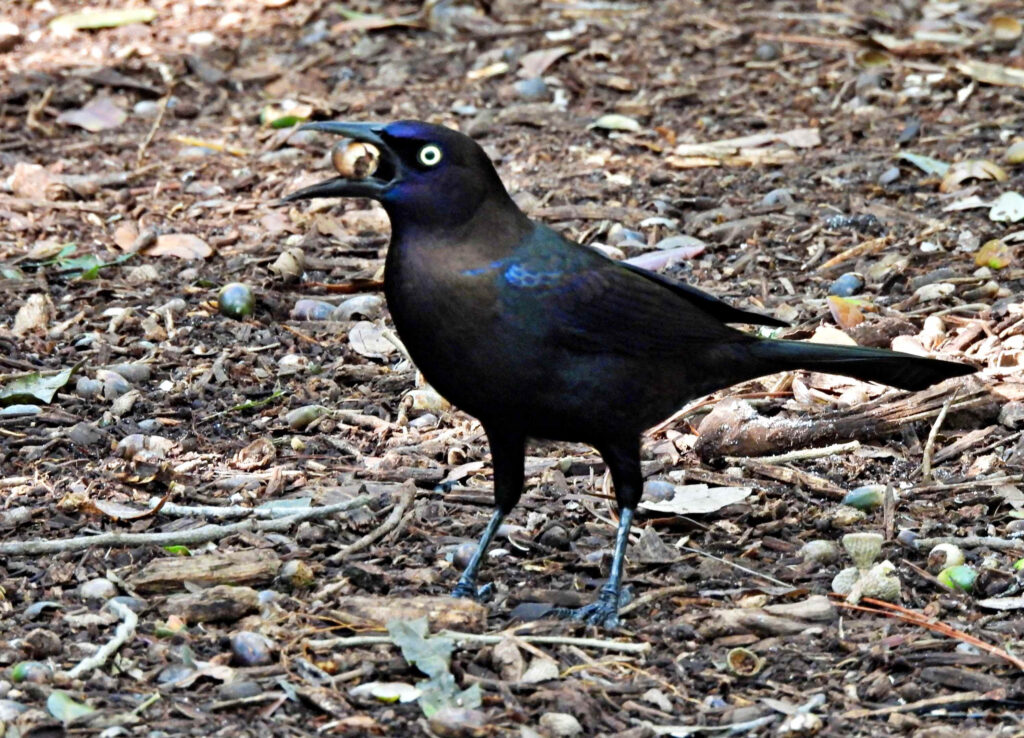
A group of grackles is known as a plague.
©iStock.com/passion4nature
As the name implies, the common grackle (Quiscalus quiscula) is prevalent throughout North America. A common backyard site, these birds look black from a distance. However, when viewed closely they are a dark iridescent bronze-black with a blue head. Smaller than the American crow, grackles generally weigh 70-140 grams and measure 11-13 inches in length, with an average wingspan of 14-18 inches.
Grackles are social birds that colonize in big flocks. They are incredibly noisy, vocalizing constantly as they stiffly strut around on long legs. Highly adaptable, grackles can be found in numerous habitats including forests, woodlands, and meadows, as well as in cities, suburban neighborhoods, and farmlands.
2. Purple Martin
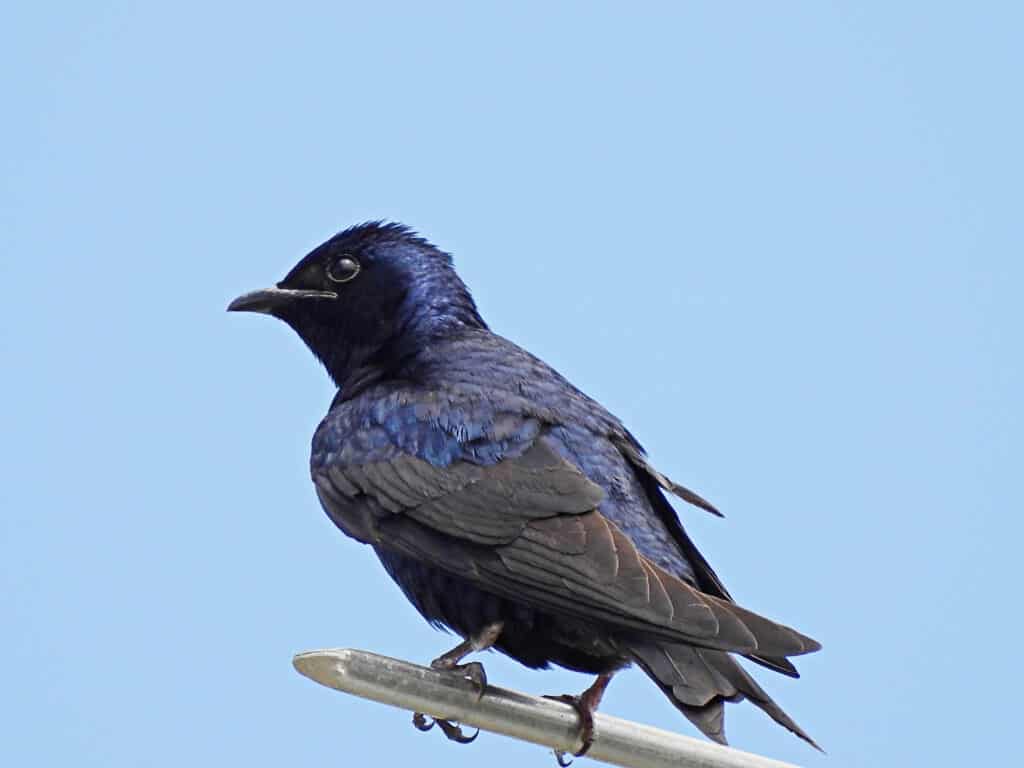
Purple martins eat and drink while in flight, skimming water off of ponds and lakes as they fly over.
©iStock.com/passion4nature
Another beautiful iridescent bird, the purple martin (Progne subis) is the largest member of the swallow family. Like the grackle, these birds appear black but have a shiny dark blue sheen. Martins are sexually dimorphic, meaning the males and females look different from one another. Males are the only ones that have black and blue coloration. Females are duller in color and do not have the same dark iridescence. They often resemble a tree swallow with a whiteish belly, while the male’s underside is completely dark.
Purple martins are famed aerialists found across Central America and in the United States east of the Rocky Mountains and along the Pacific Coast. In winter, martins migrate in large groups to South America. Once the chicks leave the nest in late summer, they roost in huge colonies that can include thousands of birds. Despite the fact that the individual birds are only 7.5-8.5 inches in length, these groups can be so large that they register on weather radar.
3. Shiny Cowbird
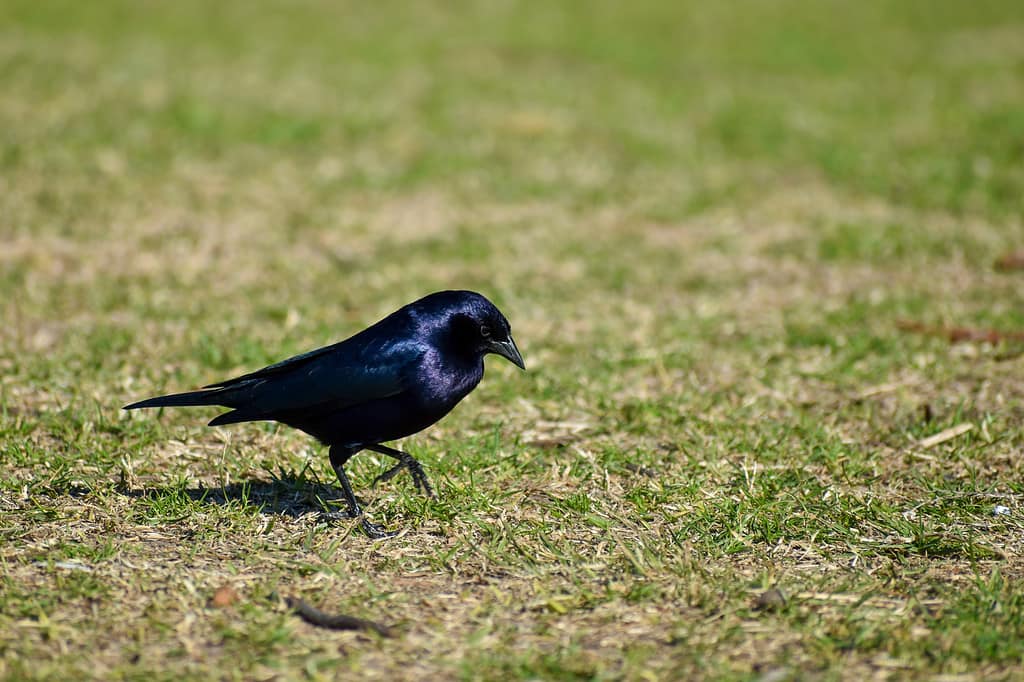
Female shiny cowbirds often remove one egg from a nest before laying one of their own in its place.
©Christian Peters/iStock via Getty Images
The shiny cowbird (Molothrus bonariensis) is a common site across most of South America and the Caribbean. Its territory is also slowly expanding into the United States. The males resemble grackles in coloration and are shiny and deep blue-black in color. Females do not share this dark coloration and are brown with a black beak, similar to a brown-headed cowbird. Both males and females are similarly sized, weighing 30-40 grams and measuring around 7 inches in length.
Cowbirds are brood parasites, which means they lay their eggs in the nests of other species. These sneaky birds never build their own nests or raise their own babies. Instead, female cowbirds wait until another bird leaves its nest, and deposit one of her own eggs in with the existing eggs of the other species. They then leave the egg to be incubated and raised by the other female.
4. Great-Tailed Grackle

The great-tailed grackle was first introduced to Mexico during the reign of Aztec ruler Ahuitzotl.
©Melinda Fawver/Shutterstock.com
Great-tailed grackles (Quiscalus mexicanus) are also known as Mexican grackles. Native to North and South America, it closely resembles the common grackle, with the exception of its tail. The great-tailed grackle’s tail is approximately the same length as its body, doubling its overall length.
This bird is also larger in general than the common grackle, measuring 15-18 inches long and weighing 115-265 grams depending on sex. Unlike the common variety, the great-tailed exhibits greater sexual dimorphism. While the males are black and iridescent, the females are dark brown with buff-colored throats. However, like their common counterparts, this species is gregarious, talkative, and known for being noisy.
5. Brewer’s Blackbird
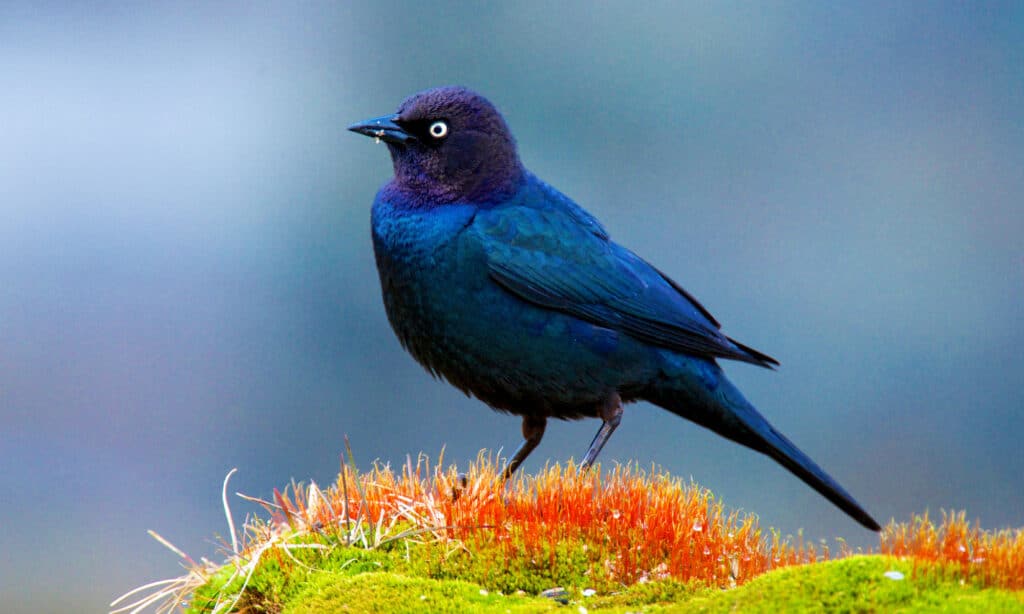
There are an estimated 23 million breeding pairs of Brewer’s blackbird globally.
©Danita Delimont/Shutterstock.com
Widespread year-round across the American West, the Brewer’s blackbird’s (Euphagus cyanocephalus) range spread east into the Great Lakes region in the 20th century. A medium-sized blackbird weighing around 60 grams, males are glossy black with blueish-purple sheens on their heads. Females are brown with dark wings and tails, and some have iridescent backs.
Brewer’s blackbirds typically nest in trees or bushes near water. Nest building takes the female five to 10 days. After the nest is built, she lays three to seven eggs per clutch. Eggs are around 1 inch long and are pale grey-green with light spots. Although Brewer’s blackbirds are 8-10 inches in length, their nests are about 6 inches across and 2 inches deep.
6. Tree Swallow
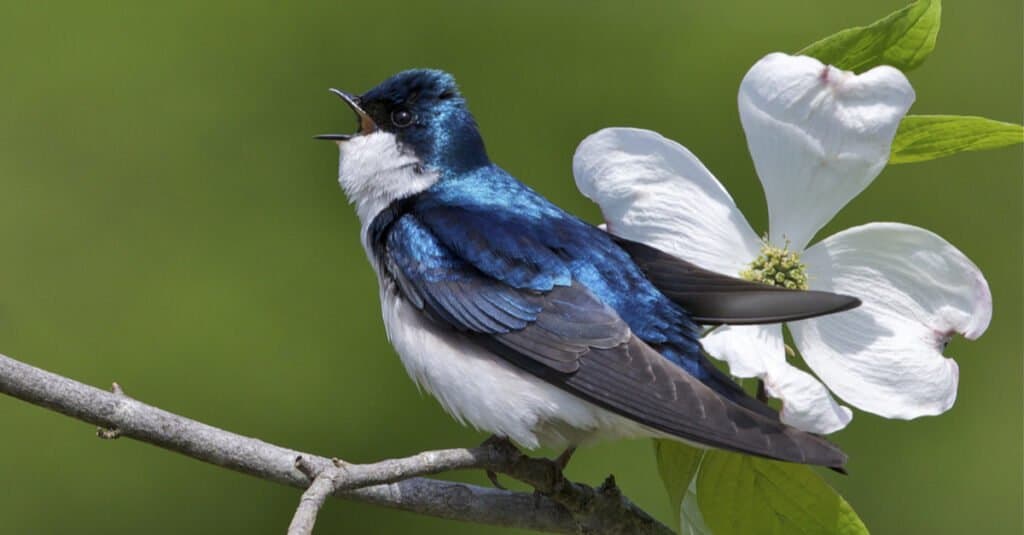
Tree swallows have more than a dozen different vocalizations.
©Tom Reichner/Shutterstock.com
While tree swallows (Tachycineta bicolor) aren’t completely black, the contrast of the adult’s blue head and shoulders with their black wings is striking. These bold colors and white underbelly make the tree swallow a distinctive songbird. Small and light, these birds measure 4.5-6 inches in length and weigh only 16-25 grams.
Tree swallows are a streamlined shape, which helps them in the aerial acrobatics they are known for. Swallows swoop and dive to catch insects midair and are found in enormous communal groups in nonbreeding season. Migratory birds, tree swallows live throughout most of Central and North America, with territory extending from Panama to Alaska.
7. Black-Throated Blue Warbler

Black-throated blue warblers prefer to nest in shrubs rather than treetops.
©iStock.com/BrianLasenby
If you hear birdsong that sounds like “I-am-so-la-zy,” there’s probably a black-throated blue warbler (Setophaga caerulescens) nearby. This distinct song is a trademark of the male birds with a black face and underwings, a beautiful blue head and back, and a bright white belly.
This coloration is exclusive to males of the species. Females look so drastically different with olive-brown plumage that they were originally believed to be two different species. Both sexes are tiny, weighing 8-12 grams and measuring just 4.3-5.1 inches long, with an average 7.5-inch wingspan. While tiny, these little birds are hardy. The oldest black-throated blue warbler on record was a female banded in 1985 in New Jersey. She died in Panama in 1985 at least nine years and eight months old.
8. Blue-Black Grosbeak

Blue-black grosbeaks have incredibly strong beaks that can easily crush seeds and nuts.
©Leon Gin/iStock via Getty Images
While there are several types of grosbeaks in North America, the brilliant blue-black grosbeak (Cyanoloxia cyanoides) is native to southern Central and northern South America. Stout and chunky, they have incredibly strong, large beaks that allow them to crush seeds before they eat them. As with many sexually dimorphic species, males are blue-black overall with lighter blue eyebrows, while females are dark brown.
Similar in size to other grosbeak species, the blue-black grosbeak is around 7-8 inches long and weighs 35-65 grams. Generally found in pairs, these birds prefer humid evergreen forests in tropical lowlands where they feed on seeds, fruit, insects, and small invertebrates.
9. Southern Cassowary

The southern cassowary is the world’s most dangerous bird thanks to its powerful legs and 4-inch claws.
©Danny Ye/Shutterstock.com
The southern cassowary (Casuarius casuarius) is a flightless bird native to northeast Australia, Papua New Guinea, and Indonesia. An endangered species, it is estimated that there are fewer than 4,600 cassowaries left in the wild. Cassowaries are the third largest bird in the world after emus and ostriches and can measure up to 5.5 feet tall and weigh 120-175 pounds.
Adult cassowaries have black bodies with long, smooth feathers. Their bright blue necks and two red wattles are very distinctive, as is the crest on their heads that is reminiscent of a dinosaur’s. The purpose of this crest (called a casque) has been unknown for many years. However, recent research believes that the casque helps keep the birds cool in the hot climates of the South Pacific. The cassowary offloads heat through the casque to regulate their body temperatures, with the crest serving as a thermal window.
Summary of 10 Black Birds With Blue Heads
| Bird Name | Scientific Name | Size & Appearance |
|---|---|---|
| Common grackle | Quiscalus quiscula | Iridescent black and blue, 70-140 grams, 11-13 inches long, with 14-18 inch wingspans. |
| Purple Martin | Progne subis | Males are iridescent black and blue, while females are less glossy and have white bellies. 45-60 grams, 7.5-8.5 inches long. |
| Shiny cowbird | Molothrus bonariensis | Males are iridescent black and blue, while females are brown with a black beak. 30-40 grams, 7 inches long. |
| Great-Tailed Grackle | Quiscalus mexicanus | Sexually dimorphic, with black males and brown females with a buff throat. 115-265 grams, 15-18 inches long with a long tail. |
| Brewer’s Blackbird | Euphagus cyanocephalus | Males are glossy black with a blue sheen, while females are brown with dark wings and tails. 60-70 grams, 8-10 inches long. |
| Tree Swallow | Tachycineta bicolor | Both males and females have blue heads and black wings with a white underbelly. 16-25 grams, 4.5-6 inches long. |
| Black-Throated Blue Warbler | Setophaga caerulescens | Males and females look drastically different; males are black with a blue head and white underbelly, and females are olive-brown. 8-12 grams, 4.3-5.1 inches long. |
| Blue-Black Grosbeak | Cyanoloxia cyanoides | Blue-black males with light blue eyebrows, dark brown females. 35-65 grams, 7-8 inches long. |
| Southern Cassowary | Casuarius casuarius | 5.5 feet tall, 120-175 pounds with black body, blue head, red wattles, and a large casque. |
The photo featured at the top of this post is © iStock.com/Henry Soon
Thank you for reading! Have some feedback for us? Contact the AZ Animals editorial team.






